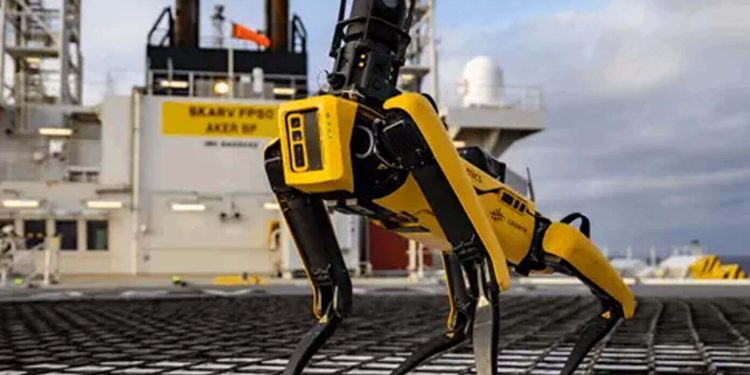Industrial robots have been used for a myriad of industrial applications. One field which has greatly benefitted from robotics is the oil and gas industry. It has helped the industry improve operations from the back office to the remotest offshore asset and improve safety and productivity.
Several tasks of offshore oilfield workers are extremely dangerous. Industrial robots save humans from encountering the riskiest situations on the rig while improving productivity and eliminating chances of errors.
Drones extending human abilities
Unmanned aerial vehicles (UAVs), also called drones, are transforming how inspections and maintenance of assets such as pipelines, well-sites, storage tanks, and offshore platforms are performed.
They integrate high-resolution sensors and cameras to collect visual data on the condition of the assets, which is beneficial in many ways:
- The amount of effort and cost is greatly reduced: There is minimum or no need to erect and take down scaffolding, which also enhances the safety of the workers by eliminating the need for humans to enter confined spaces or work at height.
- UAVs are equipped with various sensors such as optical gas imaging, radiometric thermal sensors, LiDAR, hyperspectral, and others, which expand their capabilities and widens their applications.
- Data from drones are more accurate and provide trends undetectable by the human eye.
Robots for special tasks
The Taurob Tracker is a type of specialized robot, which Equinor energy company is testing for its oil and gas facilities. The robot resembles a giant disembodied Meccano arm supported by the miniaturized bottom half of a tank and is equipped with an intuitive control system.
It is capable of reading valve positions, level gauges, and dials and monitoring concentrations of harmful gases, and moving up and downstairs.
Some other examples are:
- Inspection robots can endlessly and tirelessly cycle through several rounds of meticulous inspections without fatigue or boredom impacting their judgment. The CIRRIS XI™ and CIRRIS XR™ robots by ULC Robotics are two examples of inspection robots for gas pipelines that can move throughout a gas distribution system and use sensors to measure wall thickness and stress. The benefits? These robots greatly reduce the amount of excavation required to inspect a pipeline system and even operate in extreme conditions. The data collected by them is used to ensure the structural integrity of the pipelines and alleviate risks.
- Tank cleaning is an essential but dangerous task traditionally completed by crews working in hot, secluded, and filthy conditions. But the introduction of “Sludge cleaning robots” is quickly changing the scenario and saving several precious human lives. These specialized robots are small but extremely robust and are capable of handling power tools while navigating the small entrances of storage tanks.
- Some robots can also conduct repairs on equipment if inspections reveal a problem. For example, CISBOT can seal joints in pipelines to stop leaks or even prevent them. They eliminate the need for excessive excavation and avoid disruption of service.
Deep-Sea Robots
Many of the Earth’s oil and gas resources lie beneath its oceans. But most often, these deepwater wells and pipeline systems rely on uncrewed underwater vehicles to help perform inspections, installations, maintenance, and repair. But these uncrewed vehicles need to be transported to the offshore site using a manned vessel topside.
Deep-sea robots solve these problems in many ways:
- Deep-sea robots have an underwater docking station and are controlled via remote from the rig. With the help of their snake-like body, they move through the water and get into areas inaccessible to humans. Their design is modular, so they can be customized to accomplish a wide range of jobs.
- A more advanced deep-sea robot moves with the aid of an Ethernet connection so that it can be controlled from any location with the help of 4G technology. This robot uses a self-contained battery system that reduces the carbon footprint of any company that uses it. They are used to perform inspections in an environmentally friendly way. These underwater robots have greatly reduced the number of accidents happening every year and are also great for the environment as they reduce the chance of environmental disasters, like the Deepwater Horizon spill in 2010.
Roughneck Robots
Iron Roughneck, made by National Oilwell Varco Inc., automates the repetitive and quite dangerous task of connecting drill pipes in challenging places like oil-bearing rock and the ocean, which is one of the dangerous jobs in the world. These robots make life easier for rig workers, who don’t have to risk their lives for bringing oil to us.
Ground Robots
Ground robots are fixed or mobile robots that operate semi-autonomously or manually to support various field operational activities, including – performing first-level visual and thermal gauges, inspection and maintenance tasks, read gauges, hear surrounding and mechanical vibrations, sniff gas leaks and support emergency responses. These bots comprise a base (platform), the operation controller, and payload sensors.
Automation making oil rigs safer
Claiming 167 lives, the Piper Alpha disaster remains the deadliest oil rig accident in history. It revealed how dangerous the work could be for the workers on offshore drilling platforms. Automating complete oil rigs has enhanced safety in the oil and gas sector. For example, In the North Sea, where conditions can be life-threatening, the Oseberg H oil platform has no humans on it. Even if humans do visit the platform, they do not stay long. The oil and gas platform is fully automated, setting a great example of how safety can be enhanced with automation and innovative design.
Will robots replace humans completely?
While human operators will still be required to verify inspections remotely, they can easily work from any convenient and safe location without the need to put their lives at risk. This also benefits the oil companies as Hazard pay, and other extra expenses, such as the price of the rigs, are significantly reduced.
[Also Read: Robots are Displacing Humans in the Workplace – Reality or Fear?]
Wrap Up
Robots have already secured their place in the oil and gas industry and have brought several amazing changes, but they are still evolving. Several innovations are on the horizon, which promises to boost productivity, improve cost-efficiency, and upgrade safety even more. Although the industry has been slow in robotics adoption, there soon will be a time when using advanced technologies will become ubiquitous and necessary.








